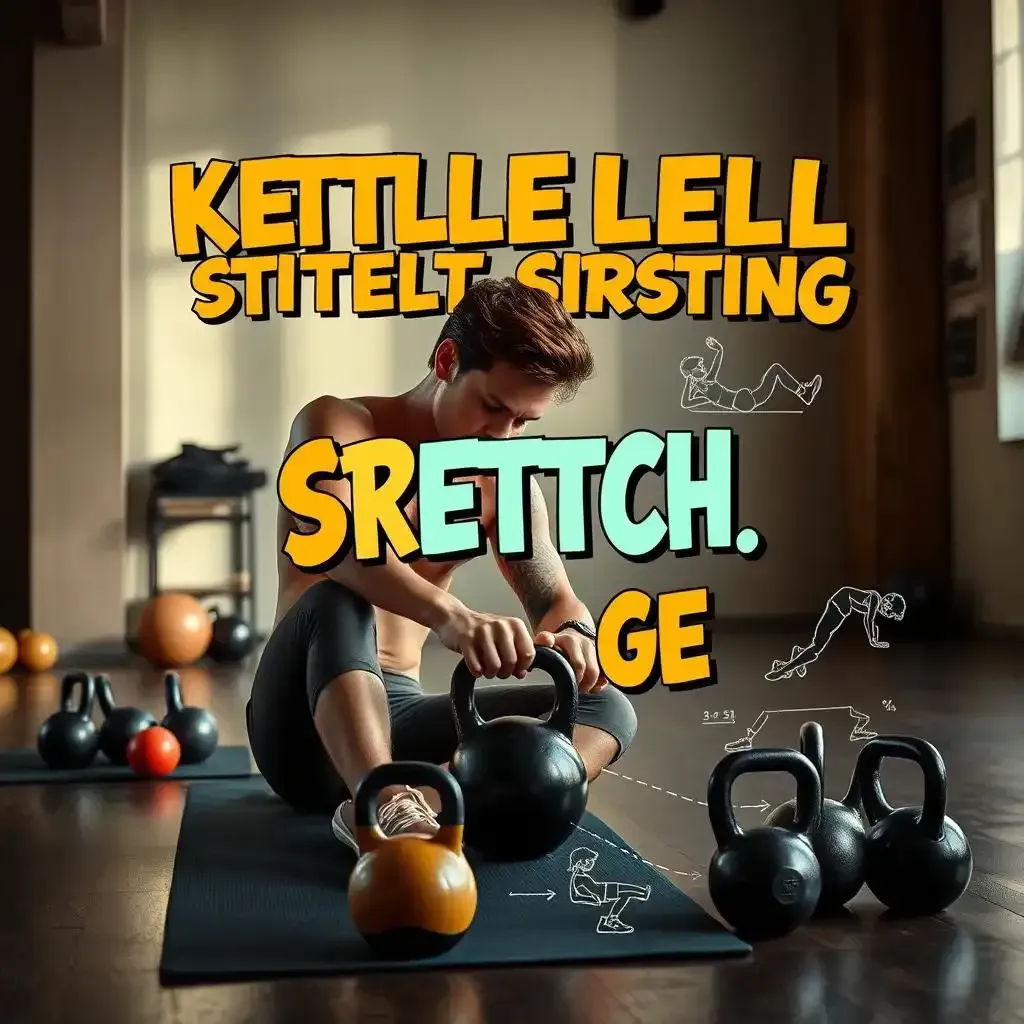Table of Contents
Hey there, fitness fans! Ever felt stiff and sore after a kettlebell workout? Or maybe you're just looking to improve your flexibility and mobility overall? Then you've come to the right place! Kettlebell training is awesome for building strength, but combining it with the right stretching routines can seriously level up your game. We're talking about preventing injuries, boosting performance, and feeling amazing. This article, created by kettlebellworkout.homes, will guide you through various kettlebell stretching routines, from beginner-friendly warm-ups to more advanced stretches targeting specific muscle groups. We'll cover everything you need to know to build a personalized kettlebell stretching routine that fits your fitness level and goals. Get ready to access a whole new level of flexibility and strength! Remember, proper stretching is crucial before and after any kettlebell workout, and ignoring this can lead to injuries. Let's investigate in and make sure you're stretching smarter, not harder!
Kettlebell Stretching Routines: Warming Up Right

Kettlebell Stretching Routines Warming Up Right
Why Warming Up is Crucial
Hey there, fellow kettlebell enthusiasts! Let's talk warm-ups. I know, I know, it feels like a drag sometimes, but trust me, a proper warm-up is like prepping your car before a long road trip—it prevents breakdowns! Think of your muscles as those car parts, they need to be ready for action. A good warm-up gets blood flowing to your muscles, increasing their flexibility and reducing your risk of injury. It's not just about avoiding pain; it's about maximizing your workout and enjoying the awesome feeling of a truly great kettlebell session. A solid warm-up helps you move with better control and precision, which means you'll get more out of each swing, snatch, and clean. Seriously, skip the warm-up and risk a pulled muscle – it’s not fun.
For example, I once skipped my warm-up, thinking I was too cool for school, and ended up with a strained hamstring. It sidelined me for weeks! Don't be like me. Remember, preparation is half the battle! Check out our guide on kettlebell warm-up exercises for some killer ideas. We've got options for every fitness level, from beginner to advanced. Don't underestimate the ability of a good warm-up!
Warm-up Type | Duration | Benefits |
|---|---|---|
Light Cardio | 5-10 minutes | Increases heart rate, warms muscles |
Dynamic Stretching | 5-10 minutes | Improves range of motion, prepares joints |
Kettlebell Swings (light weight) | 5-10 minutes | Activates muscles, improves coordination |
Dynamic Stretching: Your Secret Weapon
Now, let's chat dynamic stretching. This is where the magic happens! Forget those static stretches where you hold a position for a long time. Dynamic stretches involve movement, like arm circles, leg swings, and torso twists. They mimic the movements you'll be doing in your kettlebell workout, getting your body ready for the action. Imagine your muscles like a rubber band—dynamic stretching helps them become more elastic and less likely to snap. This kind of flexibility is key for preventing injuries and boosting your performance. I love how dynamic stretching makes me feel loose and ready to go, it's like putting on a superhero cape before my workout!
I always include some dynamic stretches before my kettlebell workouts. My personal favorites are arm circles, torso twists, and leg swings. They get my muscles fired up and feeling great, and I'm confident that I'm protecting myself from injuries. For more ideas on dynamic stretches, visit our post on kettlebell stretching guide. It's packed with awesome visuals and easy-to-follow instructions. You'll find a whole bunch of moves to add to your warm-up. This isn't just about looking good; it's about feeling good and staying injury-free!
- Arm circles (forward and backward)
- Leg swings (forward and backward, side to side)
- Torso twists
- Cat-cow stretches
- Shoulder rolls
Putting it All Together: Your Perfect Warm-up
So, here's the deal: your warm-up should be a personalized blend of light cardio, dynamic stretching, and some light kettlebell work. Start with 5-10 minutes of light cardio, like jumping jacks or jogging in place. Then, move on to 5-10 minutes of dynamic stretching, focusing on the muscle groups you'll be working. Finish with a few minutes of light kettlebell swings or other simple exercises using a lighter weight than you'd use in your main workout. Think of it as a gentle introduction to the real deal. Remember, consistency is key. Make your warm-up a non-negotiable part of your routine, and your body will thank you for it.
Don't just blindly follow someone else's routine. Listen to your body! If something feels wrong, don't do it. Adjust your warm-up to your fitness level and the specific exercises you'll be doing that day. The goal isn't to exhaust yourself; it's to prepare your body for the workout ahead. If you're new to kettlebells, check out some of our beginner routines on our website. We have some great resources for kettlebell workouts for beginners to help you start safely and effectively. Remember, safety first!
Kettlebell Stretching Routines for Flexibility and Mobility

Kettlebell Stretching Routines For Flexibility And Mobility
Hey there, kettlebell buddies! Let's talk flexibility and mobility. Think of your body as a super-cool machine, and these stretches are like its regular tune-up. You wouldn't skip oil changes for your car, right? Same goes for your muscles. Regular stretching keeps everything moving smoothly and prevents those pesky injuries that can sideline you faster than a runaway train. It's all about making sure your muscles are long, lean, and ready to rock those kettlebells!
I remember when I first started with kettlebells, I was all about the strength gains. I thought stretching was for yoga-types, not serious lifters. Boy, was I wrong! I ended up pulling a hamstring during a particularly enthusiastic swing session. Ouch! That taught me a valuable lesson: stretching isn't optional; it's essential, especially if you're working with kettlebells. Now, I prioritize my stretching routines as much as my workouts. It's a game changer. I'm more flexible, powerful, and injury-free. Check out our kettlebell flexibility exercises for some ideas.
Stretch | Muscle Group | How To |
|---|---|---|
World's Greatest Stretch | Hips, Groin, Shoulders | Start in a lunge, twist, and reach. |
Kettlebell Goblet Squat | Hips, Quads, Glutes | Hold kettlebell close to your chest, squat down. |
Hamstring Stretch | Hamstrings | Extend one leg, reach for your toes. |
One of my go-to stretches is the World's Greatest Stretch. It's like a full-body reset. You start in a lunge, twist, and reach, really working those hips, groin, and shoulders. It's amazing how much tension you can release with this simple move. I also love the kettlebell goblet squat—not just for building strength, but for increasing hip mobility. Holding that kettlebell close to your chest as you squat really opens up your hips. It's a win-win! And don't forget those hamstrings; they're often overlooked but crucial for proper movement. A simple hamstring stretch, reaching for your toes while keeping your back straight, can make a huge difference.
Remember, consistency is key when it comes to stretching. Even a few minutes a day can make a big difference. I aim for at least 10-15 minutes of stretching after each kettlebell workout. It's my way of showing my body some love and appreciation. The best part is, you can easily integrate these stretches into your daily routine. You can do them at home, at the gym, or even while you're watching your favorite show! Think of it as adding an extra layer of self-care to your fitness process. Want to learn more about avoiding injuries? Check out our kettlebell injury prevention guide.
- Always warm up before stretching.
- Listen to your body and don't push yourself too hard.
- Hold each stretch for 30 seconds.
- Breathe deeply throughout each stretch.
- Repeat stretches on both sides.
“Flexibility is not just about how far you can bend; it’s about how well you can move.” - Unknown
Another great resource for you is our guide on . It's packed with images and detailed instructions to help you master these stretches. It's like having your own personal stretching coach in your pocket! Remember, stretching isn't just about flexibility; it's about overall well-being. It helps improve your posture, reduces muscle soreness, and promotes relaxation. Think of it as a holistic approach to your fitness routine—it's not just about the weights; it's about the whole you!
Advanced Kettlebell Stretching Routines: Targeting Specific Areas

Advanced Kettlebell Stretching Routines Targeting Specific Areas
Targeting the Hips and Glutes
When it comes to advanced kettlebell stretching routines, the hips and glutes are crucial areas to focus on. Think of these muscles as the powerhouse of your body. If they're stiff, your performance can suffer. One of my favorite stretches for this area is the 90/90 Stretch. It's like giving your hips a mini massage. You start by sitting on the ground with one leg bent in front of you and the other bent behind you, both at 90-degree angles. This position really targets your glutes, piriformis, and hip flexors.
Try this stretch after a few rounds of kettlebell swings. You'll feel the difference. If you're new to kettlebell workouts, check out our guide on . It has some great tips and exercises to get you started.
Stretch | Muscle Group | How To |
|---|---|---|
90/90 Stretch | Hips, Glutes, Hip Flexors | Sit on the ground, one leg bent in front, the other bent behind, both at 90 degrees. |
Psoas Stretch | Psoas, Hip Flexors | Kneel on one knee, lean forward, and reach up with the opposite arm. |
Glute Stretch | Glutes | Lie on your back, pull one knee into your chest, and cross the other leg over it. |
Targeting the Shoulders and Upper Back
Another area that often gets overlooked is the shoulders and upper back. If you spend a lot of time hunched over a desk or phone, these muscles can get really tight. The Halos stretch is a game-changer. It's like a gentle hug for your shoulders and upper back. You hold a light kettlebell with both hands and circle it around your head. It's a dynamic stretch that helps improve shoulder mobility and stability.
I recommend doing halos as part of your warm-up routine. It's a great way to get those shoulders moving and prevent injuries. If you're looking for more shoulder-specific stretches, our guide on is a fantastic resource. It covers a range of moves to strengthen and stretch this important area.
- Halos: Hold a light kettlebell, circle it around your head.
- Shoulder Dislocates: Use a resistance band or dowel, pull it across your chest and behind your back.
- Thoracic Spine Rotations: Lie on your back, bend one knee, and rotate your upper body.
Designing Your Own Kettlebell Stretching Routines

Designing Your Own Kettlebell Stretching Routines
Personalizing Your Routine: It's All About You!
Okay, so we've covered some awesome kettlebell stretches, but now it's time to get creative! Designing your own routine is like building a LEGO castle – you get to choose the pieces that work best for you. Think about your strengths and weaknesses. Are your hips super tight? Then prioritize stretches that target those hip flexors. Got a wonky shoulder? Add in some shoulder mobility exercises. There's no one-size-fits-all approach here, pal. It's all about listening to your body and creating a routine that feels good and effective. Don't be afraid to experiment and try new things! You might find some hidden gems that become your new favorites. Remember, a good routine is one you'll stick with, so make it fun!
For example, my personal routine changes depending on what I've been doing. If I've been doing a lot of heavy squats, I’ll focus on hip and leg stretches. If I've been doing overhead presses, my shoulders get some extra TLC. It’s like giving your body a little thank you for all its hard work. Plus, I always end my routine with some gentle stretches. It's a great way to wind down and transition into relaxation mode. For more ideas on how to design your own routine, check out our . It's full of tips and tricks to create the perfect routine for you. Don't forget to check out our guide for some extra inspiration.
Body Part | Stretches | Reps/Hold Time |
|---|---|---|
Hips | 90/90 stretch, pigeon pose | 30 seconds each side |
Shoulders | Arm circles, cross-body shoulder stretch | 10 reps each direction, 30 seconds each side |
Back | Cat-cow, spinal twist | 10 reps each direction, 30 seconds each side |
Building Your Routine: A Step-by-Step Guide
Let's break down how to build your very own killer kettlebell stretching routine. First, identify your problem areas. Are your hamstrings tight as a drum? Do your shoulders feel like they're made of rusty hinges? Pinpoint the areas that need the most attention. Next, choose your stretches! We've covered a bunch already, but there are tons more out there. Don't be afraid to mix and match. You can find plenty of inspiration online or in fitness books. Remember, variety is the spice of life (and stretching!).
Now, let's talk about scheduling. Aim for at least 10-15 minutes of stretching, both before and after your kettlebell workouts. Before your workout, focus on dynamic stretches to get your muscles warmed up and ready to move. After your workout, switch to static stretches to help your muscles recover and improve flexibility. And remember, consistency is key. Even a few minutes of stretching each day can make a world of difference. It’s like brushing your teeth – you do it regularly, right? Make stretching a regular part of your routine, and you'll see and feel the amazing results! For more detailed information, check out our and kettlebell cool-down exercises guides for helpful tips. Remember, a little bit of effort goes a long way!
- Warm-up (5-10 minutes): Dynamic stretches
- Workout (30-60 minutes): Kettlebell exercises
- Cool-down (10-15 minutes): Static stretches
"Listen to your body. It will tell you what it needs." - Unknown
Final Thought
So there you have it – a comprehensive guide to incorporating kettlebell stretching routines into your fitness plan. Remember, consistency is key. Start slowly, listen to your body, and gradually increase the intensity and duration of your stretches. With dedication and the right techniques, you'll access improved flexibility, mobility, and strength, making your kettlebell workouts safer and more effective. Happy stretching!